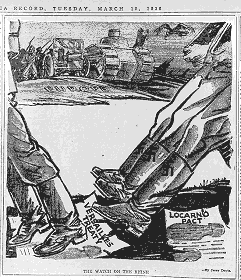|
|
|
|
A top priority of Hitler's Third Reich was territorial expansion through military conquest. To prepare for war, the regime reintroduced compulsory military service in 1935. On March 7, 1936 -- twelve days after the Winter Olympics and five months before the Summer Games -- German troops crossed the Rhine River and entered the demilitarized zone between France and Germany. The reoccupation of the Rhineland was a serious international provocation that violated the treaties of Versailles and Locarno. Hitler later reportedly admitted: "If the French had marched into the Rhineland, we would have had to withdraw with our tails between our legs, for the military resources at our disposal would have been wholly inadequate for even a moderate resistance."
|

 Jerry Doyle, “The Watch on the Rhine,” The Philadelphia Record, March 10, 1936. The illustration shows German troops trampling on papers representing the Versailles Treaty and Locarno Pact.
|
|
|
|
The Museum’s exhibitions are supported by the Lester Robbins and Sheila Johnson Robbins Traveling and Special Exhibitions Fund, established in 1990.
|
